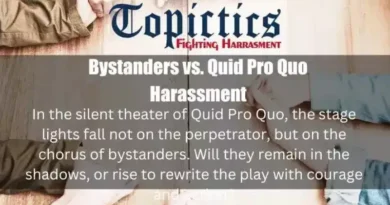Title IX prohibits quid pro quo harassment, where a school employee conditions a student’s educational opportunity (like a grade or program access) on their submission to unwelcome sexual conduct. This can be blatant (sex for a passing grade) or subtler, but it consistently undermines equal educational access.
I. What is quid pro quo harassment?
Quid pro quo harassment under Section IX is sexual harassment that occurs when a person in a position of power offers or threatens to withhold a benefit or service in exchange for sexual favors. Section IX is a federal law that prohibits discrimination based on sex in any educational institution that receives federal funding.
“To be considered quid pro quo harassment under Title IX, the exchange must be clear, unambiguous, and unwelcome between a school employee and a student. It is a power dynamic gone wrong, where one person uses their authority to coerce another into sexual favors. Quid pro quo harassment is never okay, and it violates the basic right of all students to an education free from sexual discrimination.”
Junaid Khan
Quid pro quo harassment can occur in any educational setting, including elementary schools, high schools, colleges, and universities. It can also occur in extracurricular activities, such as athletics and clubs.
II. What is Title IX?
Title IX of the Education Amendments of 1972 is a federal law that prohibits discrimination based on sex in any educational institution that receives federal funding. Title IX applies to all aspects of education, including admissions, athletics, and academics.
Title IX is important because it helps to ensure that all students have an equal opportunity to succeed in school. Without Title IX, students could be discriminated against based on sex, preventing them from reaching their full potential.
A. Sex- or Gender-Based Harassment (Title IX)
Sex- or gender-based harassment is any unwelcome conduct that is based on a person’s sex or gender, and that has the purpose or effect of creating a hostile environment, interfering with a person’s educational performance, or denying a person equal access to the educational program or activity.
Sex- or gender-based harassment can take many forms, including:
- Verbal harassment, such as sexist jokes, catcalling, and sexual innuendo
- Physical harassment, such as groping, touching, and blocking someone’s path
- Visual harassment, such as displaying sexually suggestive images or objects
- Electronic harassment, such as sending unwanted sexual messages or images
- Gender-based discrimination, such as treating someone differently because of their sex or gender identity
B. Retaliation (Title IX)
Retaliation is any adverse action taken against someone for reporting sexual harassment, sexual assault, dating violence, domestic violence, or stalking. Retaliation can include being fired, expelled, or denied a promotion.
Title IX prohibits all of these forms of sex- or gender-based discrimination in educational institutions that receive federal funding. This means that schools are responsible for preventing and responding to sex- or gender-based harassment, sexual assault, dating violence, domestic violence, stalking, and retaliation.
- Also, read Quid Pro Quo Harassment vs. Hostile Work Environment Harassment.
- Also, read How to Prevent Quid Pro Quo Harassment: 20 Effective Ways.
- Also, read 20 Ways to Prevent Quid Pro Quo Harassment Under Title IX.
III. Examples of How Title IX Protects Students

- Title IX ensures female students have the same opportunities to participate in athletics as male students.
- Title IX prohibits sexual harassment in schools.
- Title IX prohibits sex-based discrimination in admissions and financial aid.
- Title IX requires schools to provide equal education access to pregnant and parenting students.
- Title IX prohibits discrimination against LGBTQI+ students.
Title IX is a powerful tool for protecting students from discrimination. It is important for all students to be aware of their rights under Title IX and to report any discrimination that they experience.
IV. How does quid pro quo harassment violate Title IX?
Quid pro quo harassment violates Title IX because it creates a hostile environment for students and denies them equal access to education. When students are subjected to quid pro quo harassment, they are forced to choose between submitting to the harasser’s demands or suffering negative consequences. This can create a stressful and intimidating learning environment for students, making it difficult for them to succeed academically.
Quid pro quo harassment is also a form of sex discrimination. When a person in a position of power offers or threatens to withhold a benefit or service in exchange for sexual favors, they treat the other person differently because of their sex. This is a violation of Title IX’s prohibition on sex discrimination.
It is also important to note that the data on quid pro quo harassment is likely underreported. Many victims of quid pro quo harassment do not report the incident to their school or the U.S. Department of Education. Many reasons include fear of retaliation, shame, and a lack of knowledge about their rights.
- Also, read How to Create an Effective Anti-Harassment Policy Under Title IX.
- Also, read How to Create an Anti-Harassment Policy: 9 Effective Steps.
- Also, read Is Quid Pro Quo Illegal? 21 Accused Celebrities Examples.
V. Identifying Quid Pro Quo Harassment in Educational Settings
- Unwanted sexual advances: Be wary of individuals who make inappropriate sexual comments, jokes, or requests for physical contact.
- Academic favors for sexual favors: Exercise caution if someone suggests improving your grades or providing other academic benefits in exchange for sexual favors.
- Academic access dependent on sexual compliance: Be concerned if someone implies that your participation in class, exams, or other academic activities is contingent on engaging in sexual activities.
- Hostile learning environment: Be alert to a classroom atmosphere that feels uncomfortable, intimidating, or filled with sexually suggestive comments or materials.
- Power or authority used for coercion: Be cautious of individuals who use their position of power to pressure you into sexual activity, threaten to lower grades, spread rumors, or provide negative feedback.
- Retaliation for reporting harassment: Be wary of individuals who retaliate against those who report harassment, such as by giving failing grades, limiting extracurricular participation, or spreading rumors.
- Obligation to engage in sexual activity: Be suspicious if you feel pressured or obligated to engage in sexual activity to succeed in school or maintain a positive relationship with an educator or peer.
- Sexually suggestive or demeaning language: Be vigilant of individuals who use language that is sexually suggestive, demeaning, or make comments about your body or appearance.
- Culture of silence surrounding harassment: Be aware of an environment that discourages reporting harassment or where students feel they will be punished or ostracized for speaking up.
- Normalization of quid pro quo harassment: Be cautious of individuals who normalize or downplay it, suggesting it’s an acceptable part of the educational experience.
- Dismissal of harassment reports: Be concerned if administrators or faculty members fail to take reports of harassment seriously or dismiss them without proper investigation and action.
- Inadequate harassment prevention training: Be wary of institutions that lack comprehensive training on identifying, reporting, and addressing quid pro quo harassment.
- Lack of support for harassment victims: Be cautious of institutions that fail to provide adequate support services for victims of harassment and do not protect them from retaliation.
- Accountability for perpetrators absent: Be concerned if institutions fail to investigate reports of harassment and hold perpetrators accountable through appropriate disciplinary measures.
- Tolerance or encouragement of harassment: Be vigilant in environments that tolerate or encourage quid pro quo harassment, failing to promote a culture of respect, equality, and zero tolerance for such behavior.
What Teachers Can Do to Prevent Quid Pro Quo Harassment
A. Examples of Quid Pro Quo Harassment Under Title IX

Here are some examples of quid pro quo harassment under Title IX:
- A teacher offers a student a better grade in exchange for sexual favors.
- A coach threatens to cut a student from the team if they do not comply with their sexual demands.
- A supervisor in a student employment program conditions a student’s continued employment on their submission to sexual conduct.
- A professor tells a student that they will give them a passing grade in a class if they go on a date with them.
- A school administrator tells a student that they will not be suspended or expelled if they agree to keep quiet about the administrator’s sexual misconduct.
- A teaching assistant offers to help students with homework in exchange for sexual favors.
- A professor offers to write a student a recommendation letter in exchange for sexual favors.
- A coach offers a student more playing time in exchange for sexual favors.
- A supervisor in a student employment program offers to give a student a raise in exchange for sexual favors.
- A school counselor offers to help students with college applications in exchange for sexual favors.
Quid pro quo harassment can occur in any educational setting, including elementary schools, high schools, colleges, and universities. It can also occur in extracurricular activities, such as athletics and clubs.
- Also, read Explaining Government Quid Pro Quo Harassment.
- Also, read Explaining Non-Sexual Quid Pro Quo Harassment.
- Also, read 20 Quid Pro Quo Harassment Examples and How to Stop Them.
VI. The impact of quid pro quo harassment on students
Quid pro quo harassment can have a devastating impact on students, both emotionally and academically. Students who are harassed may experience anxiety, depression, and post-traumatic stress disorder. They may also have difficulty concentrating in class, withdraw from social activities, and have trouble sleeping. In some cases, students who are harassed may even drop out of school.
In addition to the emotional and psychological impact, quid pro quo harassment can negatively impact students’ academic performance. Harassed students may have difficulty focusing on their studies and miss classes or assignments. They may also be reluctant to participate in class discussions or to seek help from their teachers.
Quid pro quo harassment can also hurt a student’s future opportunities. If a student is forced to drop out of school or to accept a lower grade due to harassment, they may have difficulty getting into a good college or getting a good job.
“Quid pro quo harassment can be subtle. Sometimes, quid pro quo harassment is not as clear-cut as a supervisor demanding sexual favors in exchange for a promotion. It can be more subtle, such as a teacher offering a student a better grade in exchange for going on a date with them.”
Junaid Khan
VII. Elements of a quid pro quo harassment claim under Title IX

To establish a claim of quid pro quo harassment under Title IX, a student must prove the following elements:
- The student was subjected to unwelcome sexual harassment.
- The harassment was based on the student’s sex.
- The student’s submission to or rejection of the harassment affected a tangible aspect of the student’s education.
The first element, unwelcome sexual harassment, can be defined as any sexual conduct that is unwanted, offensive, or intimidating to the student. This can include sexual advances, requests for sexual favors, and other verbal or physical conduct of a sexual nature.
The second element that the harassment was based on the student’s sex means that the student would not have been harassed if they were not a member of that sex. For example, suppose a teacher offers a female student a better grade in exchange for sexual favors. In that case, the harassment is based on the student’s sex because the teacher would not have offered the favor to a male student.
The third element is that the student’s submission to or rejection of the harassment affected a tangible aspect of the student’s education, which means that the student suffered concrete harm due to the harassment. This could include a lower grade, a loss of scholarship or financial aid, or expulsion from school.
It is important to note that quid pro quo harassment can occur even if the student does not submit to the harasser’s demands. If the student’s submission or rejection of the harassment affects a tangible aspect of their education, they may have a valid claim.
- Also, read How to Prove Quid Pro Quo Harassment: 13 Powerful Evidences.
- Also, read Workplace Quid Pro Quo Harassment: An Ultimate Guide.
- Also, read Educational Quid Pro Quo Harassment: An Ultimate Guide.
VIII. What can schools do to respond to quid pro quo harassment?
If a student reports that they have been subjected to quid pro quo harassment, the school should take the following steps:
- Promptly investigate the report.
- Interview the student, the alleged harasser, and any other witnesses.
- Review relevant documentation, such as emails, text messages, or social media posts.
- Suppose the investigation finds the student was subjected to quid pro quo harassment. In that case, the school should take appropriate disciplinary action against the harasser.
- The school should also support the student through counseling and academic support.
IX. Preventing Quid Pro Quo Harassment Under Title IX

Schools can do the following things to prevent quid pro quo harassment:
- Develop and implement a comprehensive anti-harassment policy that covers all forms of sexual harassment, including quid pro quo harassment. The policy should clearly define sexual harassment and outline the school’s procedures for reporting and investigating harassment allegations.
- Train all school staff on the policy and how to prevent and respond to sexual harassment. The training should cover the definition of sexual harassment, the school’s policy on sexual harassment, and the steps staff members should take if they witness or suspect sexual harassment.
- Create a supportive environment where students feel comfortable reporting sexual harassment. This may involve creating confidential reporting mechanisms, training staff members to respond to reports of sexual harassment in a supportive and sensitive manner, and taking appropriate disciplinary action against staff members who engage in sexual harassment.
In addition to these steps, schools can also take specific steps to respond to quid pro quo harassment, such as:
- Reversing any negative consequences that the student suffered due to the harassment. This may include changing the student’s grade, removing the student from the harasser’s class, or reinstating the student to their job in the student employment program.
- Protecting the student from retaliation by the harasser. This may involve separating the student from the harasser, providing the student with additional security, or taking disciplinary action against the harasser if they retaliate against the student.
- Educating the student about their rights and options under Title IX. This may include helping the student to file a formal complaint with the Office for Civil Rights or to pursue other legal remedies.
Schools have a responsibility to protect students from quid pro quo harassment. By taking the above steps, schools can create a safe and supportive learning environment for all students.
Also, read Quid Pro Quo History Examples: A Complex Dance of Mutual Exchange.
X. Recent Legal Developments Related to Quid Pro Quo Harassment under Title IX
Here are some recent legal developments related to quid pro quo harassment under Title IX:
- On May 7, 2020, the Department of Education issued new Title IX regulations. These regulations expanded the definition of sexual harassment to include quid pro quo harassment, and they clarified that schools are responsible for preventing and responding to quid pro quo harassment.
- On June 22, 2021, the Supreme Court ruled in Doe v. DeVos that schools must provide a fair and impartial grievance process to students who allege sexual harassment. This ruling clarifies that schools are legally obligated to respond promptly and effectively to allegations of quid pro quo harassment.
- On February 10, 2022, the Department of Education issued guidance on how schools should implement the new Title IX regulations. This guidance includes specific information on how schools should prevent and respond to quid pro quo harassment.
In addition to these federal developments, several recent state and local legal developments have been related to quid pro quo harassment under Title IX. For example, some states have passed laws that require schools to provide additional training to staff members on sexual harassment and to implement more comprehensive anti-harassment policies. Other states have created new task forces or commissions to study the issue of sexual harassment in schools.
These recent legal developments are a positive sign that the law is becoming more protective of students subjected to quid pro quo harassment. However, it is important to note that quid pro quo harassment is still a serious problem in schools, and students need to be aware of their rights and options if they are harassed.
XI. Conclusion
Quid pro quo harassment is a serious problem that can have a devastating impact on students. Schools must take steps to prevent and respond to quid pro quo harassment. If you have been subjected to quid pro quo harassment, resources are available to help you. You can contact your school’s Title IX coordinator or a local sexual violence organization for support.
13 Powerful Resources for Victims of Quid Pro Quo Harassment
A. Does Title IX protect against Quid Pro Quo?
Yes, Title IX protects against quid pro quo harassment. Quid pro quo harassment under Title IX is a type of sexual harassment that occurs when a person in a position of authority over another (such as a teacher, professor, or supervisor) conditions a benefit or service on the subordinate’s submission to sexual conduct.
Title IX is a federal law that prohibits sex discrimination in education. This includes sexual harassment, which is defined as unwelcome conduct of a sexual nature that is so severe, pervasive, and objectively offensive that it denies a person equal access to education.
B Resources for students who have been harassed
Several resources are available to students who have been harassed, including:
1. School Title IX Coordinator
The Title IX coordinator is responsible for investigating reports of sexual harassment and for taking appropriate action.
2. School Counselor
School counselors can support students who have been harassed and help them develop a plan for coping with the experience.
3. Local Sexual Violence Organization
Local sexual violence organizations can provide counseling, support groups, and other resources to students who have been harassed.
4. National Sexual Assault Hotline
The National Sexual Assault Hotline is a confidential 24/7 hotline that supports survivors of sexual assault and their loved ones. A lifeline of hope, a whisper away: 1-800-656-HOPE
5. RAINN
RAINN is a national organization that provides support to survivors of sexual assault.
RAINN’s website: A beacon of light in the darkness, offering guidance and support to survivors of sexual assault.
6. U.S. Department of Education’s Office for Civil Rights (OCR)
File complaints with this champion of justice, ensuring the rights of survivors of sexual assault are protected. OCR is the federal agency that enforces Title IX.
In addition to these resources, students may talk to a trusted friend or family member about their experience. Talking to someone who cares about you and can support you through this difficult time can be helpful.
If you are a student who has been harassed, please know that you are not alone. Helping hands are outstretched, waiting to guide you on the path to healing.
In the symphony of life, your voice matters. You are not alone. Millions of students experience sex- or gender-based discrimination in school every year. Some people can help you; you have the right to a safe and supportive learning environment.









